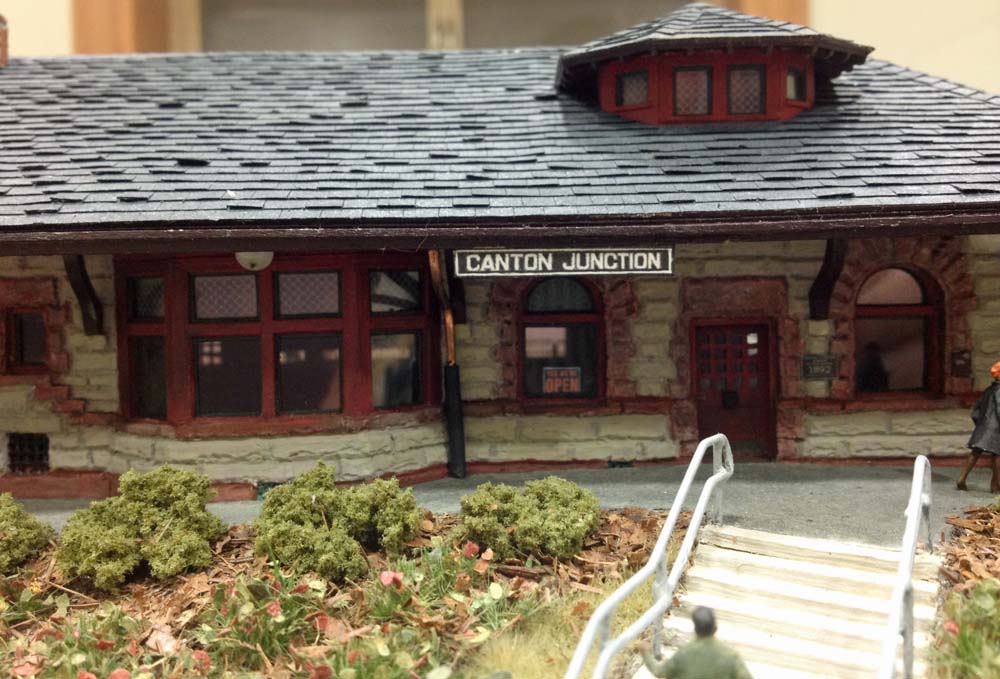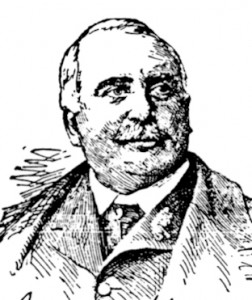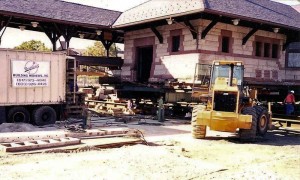True Tales from Canton’s Past: A Model Landmark
By George T. Comeau
A detail from the scale model of Canton Junction on display at the Canton Public Library (Courtesy of the author)
Chris Fisher lives on Indian Lane here in Canton. Fisher’s hobby is making scale models — not airplanes or cars, but buildings, which are his passion. Having spent months working on his masterpiece, a scale model of one of Canton’s most historic landmarks, all that remains now for Fisher is to find a place to display his work.
On a cold November day Fisher walked into the Canton Public Library hoping to find such a home. Library Director Mark Lague recalls the conversation: “Skeptically, I explained that the Board of Trustees would have to see any models that would be displayed.” Imagining crude boxes and perhaps Popsicle sticks, Lague was cautious to accept the model sight unseen.
Many people donate items to the library or ask to have mementos exhibited in the interest of sharing them with the town. Over the years the library has accepted paintings, photographs, books, and even model dollhouses. In the Reference Room high on a shelf sits a replica of the Canton Viaduct, made by Canton native Ed Costanza, who now lives in Arizona. Costanza boarded a plane with his model, which is made from Lego building blocks. It was an amazing sight to see the familiar structure rendered in detail built of the ubiquitous childhood toy.
Fisher, however, is a different kind of model builder, and he set his eyes on the Canton Junction. The familiar stone and slate building at the bend of Beaumont and Sherman streets is one of the finest examples of its type in the country, so why not make a model of it?
There are several train enthusiasts in Canton. Most notably, Chris Podgurski took his passion for railroads to a whole new level when he actually purchased the Massachusetts Coastal Railroad shortline on Cape Cod. Podgurski started out building model railroads in his basement and showing off the miniatures to family and friends. Modeling, quite honestly, is more than a hobby. For some it is an all-consuming passion.
Fisher would spend more than eight months building Canton Junction. Explaining his work, Fisher traces his interest to growing up and seeing the village diorama at the Mystic Seaport. “I learned the techniques as a kid,” he said, “and I was always fooling around with house shapes and cardboard, and it evolved into an interest in architecture.”
Fisher’s first successful models were houses, which he built in high school. “I got hold of a set of plans to a house, so I built it,” he said of his first “real homemade model,” which he still has.
Fisher’s roots are here in New England, and he is the seventh generation in this area. Growing up in Foxboro, he would commute through Canton on his way to college at Wentworth Institute of Technology. Earning an associate’s degree, Fisher moved into a career that focused on engineering: drawing bridges in Massachusetts and Rhode Island.
With pride, Fisher described the bridge near the country store in Mansfield, the blueprints of which were his. “Riding the train all those years ago,” he said, “I guess I saw Canton Junction, but when I moved here eight years ago, I really began to see it in a new way.”
Taking on one of Canton’s most iconic landmarks would be no easy feat, as Fisher would be copying one of America’s foremost architects of railroad structures. The “big” Canton Junction was designed by Bradford Lee Gilbert and built between 1892 and 1893. This station is the second oldest railroad structure designed by Gilbert in Massachusetts, where he designed nine such structures for various railroads. In fact, Gilbert spent a lifetime working on railroad buildings. At the age of 23, Gilbert began work for the New York, Lake Erie, and Western Railroad. Grand stations called for grand architects, and he remodeled the old Grand Central Station in New York City.
The architectural style of Canton Junction is called Richardsonian Romanesque, named for buildings that resemble the work of H.H. Richardson. But in fact, Gilbert’s work is different in some important respects, and more aptly described as purely Romanesque, with European sensibilities that combine arches, graceful curves, double-thick walls, and roofs reminiscent of overhanging thatch. If you picture Canton Junction in a French-gothic village — you get the idea.
The “gothic” style is what Fisher loves. The mansion at Borderland, Foxboro Memorial Hall, and perhaps even our own Town Hall, are all the kind of buildings that Fisher dreams about modeling. Fisher modeled Canton Junction in HO scale, the most popular model railroad scale in continental Europe and North America. By scale, we are referring to size, where the actual building is 87 times larger than the model. HO scale is what made model railroads popular in America, enjoying popularity in the 1950s when realism in the hobby demanded detail.
As for detail, the model that Fisher built of the Canton Junction is amazing. When you look at a photo of the model, it is nearly impossible to discern that you are looking at anything other than the real thing. When Fisher carried the model into the Canton library, Lague’s jaw dropped. “It was stunning,” he said, “and every single detail was there. I had absolutely no idea that this model would be perfect.”
Perfection is key to Fisher’s work. “All the time, I look at things, details, and think about how I would model,” he explained. “Canton Junction is recycled old stuff. The structure is cardboard scraps. I made the doors and windows out of craft plywood or layered paper and cardboard. I used clear plastic and applied photos of the stained glass, which were photoshopped, sized and pasted in place. I covered the whole thing with oven-baked clay, glued soft and sculpted each wall. I then baked the walls and then assembled and baked the corners of the building. The eaves and roof is all cardboard. Framing on the inside made the model solid.”
If this sounds difficult, it is. Starting the work took dozens of visits to measure the building. “I often wondered why no one ever stopped me,” said Fisher, who would show up with a notebook and a 25-foot ruler whenever he needed a new detail. Two words describe the work: “repetitive and intricate.” The most amazing detail is the slate roof, where thousands of small cuts give texture to misted cardboard, precisely copying the roof of the real Junction.
The original is also amazing when you look at it. Constructed for the Old Colony Railroad, the 120-year-old building is built out of Milford Pink Granite and trimmed in brown stone. Yellow pine moldings curve elegantly to support a massive roof that extends well beyond the building, providing cover for the platforms below. Measuring 25 feet by 86 feet, exclusive of platforms, the station has withstood the test of time, mainly because it is still used today.
By the late 1980s the building may well have been slated for demolition. The condition was deplorable; broken glass, rotted floors, and timeworn facilities made the station vulnerable to changes. The local historical commission worked to elevate the status of the landmark, achieving National Register eligibility, which likely saved the station from the wrecking ball. The MBTA wanted to make the station accessible, and poured concrete ramps and high platforms were to destroy the façade of the landmark.
After years of wrangling, the MBTA decided to renovate one of their last remaining historic railroad stations. Millions of dollars brought the building back to life, preserving the station. In 1998, a new threat surfaced — that of high-speed Amtrak Acella service, meaning that the building was “literally in the way” of a new track being run between Boston and New York.
The solution was to relocate the station 70 feet southeast of its original location. The station was picked up, placed on rails, and slid back onto a new foundation where it sits today, safe and secure. The second home for this National Historic property is set on a slight hill and pitched at an angle to the street. The model shows every detail, right down to the newspaper boxes and custom railings under the awnings.
Fisher started work in March 2011 and spent eight months working anywhere from a few hours to days on end completing his work. The original Junction cost under $9,000 to build; Fisher calculates that his model cost about $100. “The materials I used were found materials and largely free,” he said. “The stuff I bought — plywood, basswood, and the display case of Plexiglas — were inexpensive.” Fisher bought five small cars at $12 each, a few “little people” he had in stock, and found a train, described as a “lucky find at a model train show in Hingham’s Bear Cove Park.”
In the end, there are now two Canton Junctions, both on Sherman Street, and the new model is now on display just inside the main entrance of the library. Visit the model and truly admire the details, seen nowhere else, save for the original, just half a mile away. For Fisher’s part, he hopes the town will appreciate the work in his diminutive station.
“I am very happy with it,” he said, “and I’m hoping it will be on display with the town, shared with people, and a little kid might look at it and decide, like I did, to take on modeling some day. I don’t want it to sit in my basement. It needs to be enjoyed.”
Short URL: https://www.thecantoncitizen.com/?p=18065












